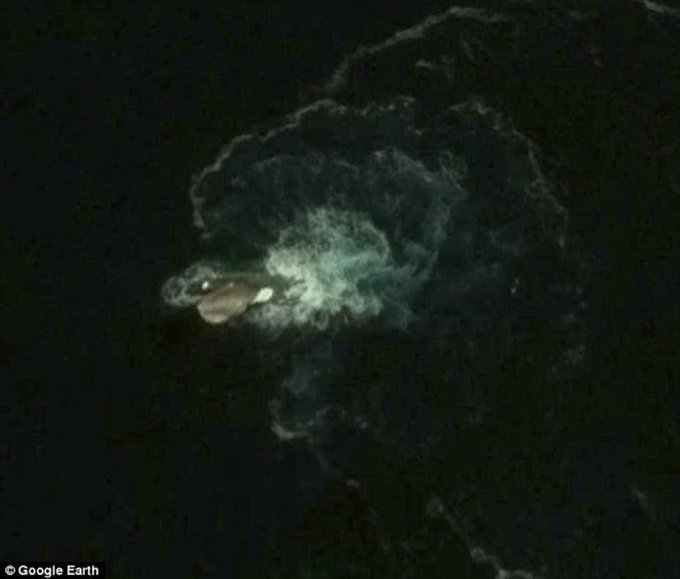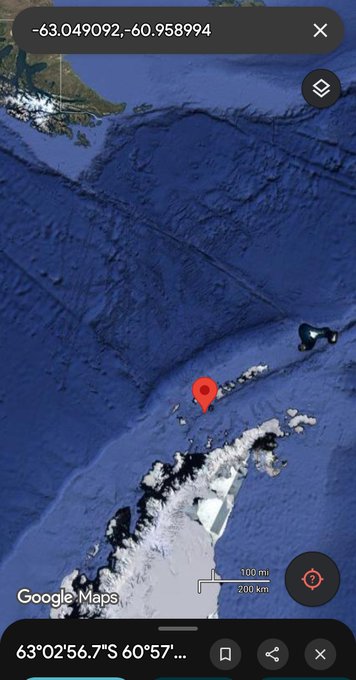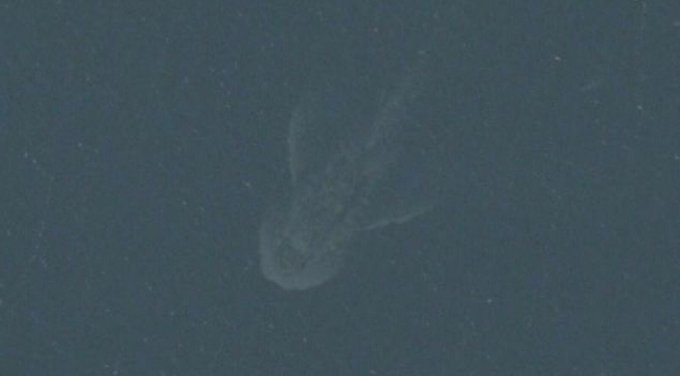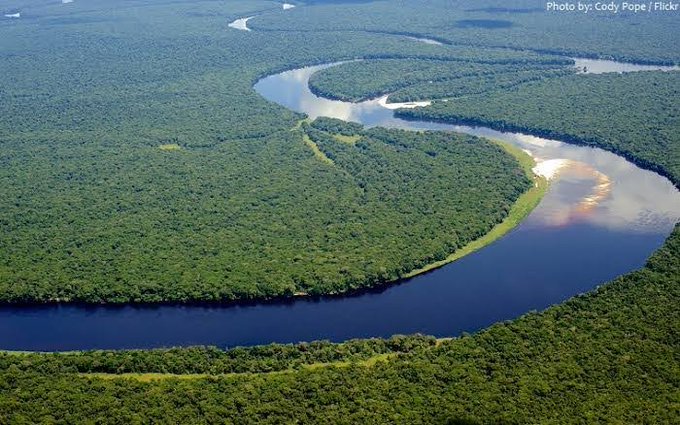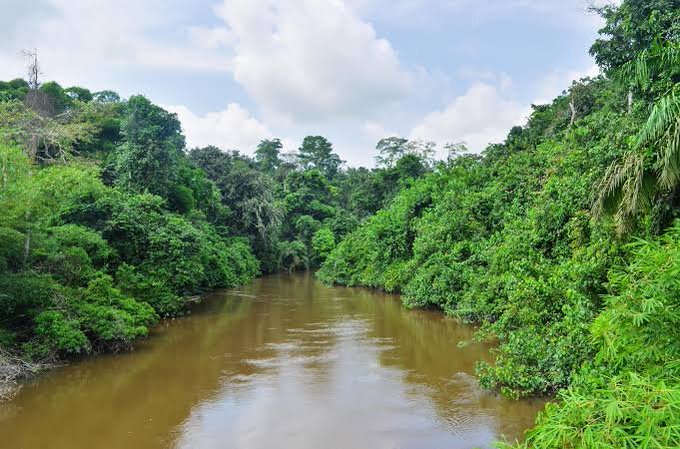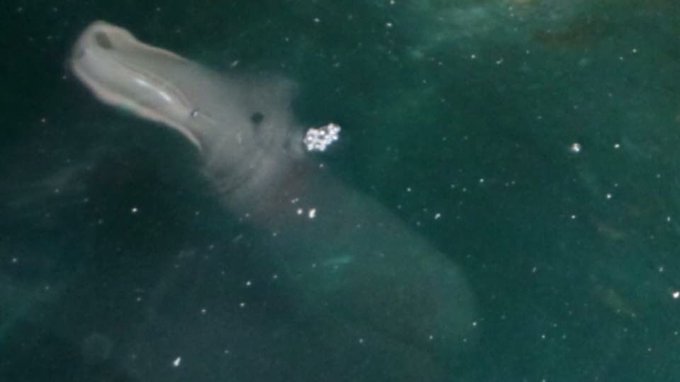In our incredibly, technologically-advanced age of Google Earth, Apple Maps, and many other satellite imagery systems, it’s possible to travel the world without stepping foot on a plane. And, if you do take a Google Earth world tour, you’re bound to stumble upon some things that aren’t exactly ordinary.
Not all lifeforms caught on Google Maps are as easily identified. From jaw-dropping cryptids to Antarctic aliens, let’s investigate some of the most mysterious creatures spotted by virtual globetrotters across the internet!
The Kraken
Legend has it that a fierce sea creature, the Kraken, once ruled the seas by swallowing ships, whales and terrified sailors with the help of its deadly tentacles. Nordic folklore has mentioned the Kraken since the 18th century, often depicting it as an enormous octopus with deadly spikes on its suckers. But could such a thing, vastly exceeding the largest-known giant squids, be real?
Well, in April 2016, the
Kraken was reportedly sighted by UFO enthusiast, Scott C. Waring, on Google Earth just off the coast of Deception Island, Antarctica. Scott, using Google’s built-in ruler, determined the creature to be about 100 feet long from top to bottom, with the potential to be even longer if you added its tentacles. Only the problem is, you can’t see any tentacles. Or much of anything else, for that matter. As it turns out, there’s actually a pretty grounded explanation behind the Kraken’s snapshot. Deep-sea biologist, Andrew David Thaler, of ocean blog, Southern Fried Science, pointed out that the image wasn’t of a shipwrecking monster, but a rock. Thaler pointed out that on any navigational map of the South Shetland Islands in Antarctica, you’ll see the coordinates of the alleged anomaly labelled as Sail Rock, a well-known formation.
Loch Ness Monster
If you’ve heard of the Loch Ness monster, you’ve probably seen this iconic 1934 photograph by English physician, Robert Kenneth Wilson.
Even though that photo was ultimately exposed in 1994 as no more than a plastic-and-wooden head attached to a toy submarine, it hasn’t stopped cryptid enthusiasts from continuing to try capturing Nessie on camera. That includes Ohio woman Lisa Stout, who in 2018 stumbled upon what she claimed was Nessie while casually exploring Scotland’s Loch Ness on Google street-view. She noticed a dark figure emerging from the water, and claimed she saw an eye and partial lining of a mouth on the creature’s left side, although to me, it looks too blurry to tell.

Gary Campbell, the recorder and keeper of the official Loch Ness Monster Sightings Register said that because no one on the panel could offer up an explanation, they were listing the incident as the ninth official Nessie sighting of 2018. However, seeing as Lisa never provided any precise coordinates for others to check her claim themselves, I’m not convinced. If anything, the supposed Nessie was likely a surfacing tree trunk, and here’s why. When the branches of the surrounding Scottish Pine-trees fall into the loch, the pine resin inside traps tiny oxygen and carbon dioxide bubbles within the wood as it decays. Occasionally, enough of these bubbles gather to float the trunk upward like a pool noodle, causing it to surface like an animal coming up for air. At least, that’s one possible explanation!
Other Nessie sightings are decidedly more beast-like in appearance. Like this shadowy form caught on Apple Maps on the Loch.
The figure, which is estimated to measure about 100-feet, and looks like it has two flippers propelling it forward, was studied for six months by Gary Campbell and his highly-official Loch Ness Monster Fan Club, before they once again concluded it was very likely to be the slippery rascal, Nessie. Despite the club’s claim, however, another explanation for the shape quickly surfaced among skeptics. Deep-sea biologist, Andrew David Thaler, the same guy who weighed in on the alleged Kraken earlier, chalked the Nessie sighting up to the
inaccurate stitching of photos that sometimes occurs with satellite imaging. Usually, satellite apps stitch several pictures of the same scene together to form a more cohesive view of the world below, and the programs occasionally glitch out. Thaler suggested a couple of snapshots featuring a moving boat were stitched with some others taken a few seconds later, inadvertently deleting the boat, or at least fading it out almost completely, leaving only the wake and choppy water in front of it.
Borneo's Giant Snake
In February 2009, a member of a disaster team monitoring flood regions across Borneo reportedly captured this shocking, and conveniently-pixelated, image while flying over the river Baleh in a helicopter.
The shot, which shows an alleged 100-feet-long, wavy object floating along the river, sparked rumors that a mythical, shape-shifting snake called Nabau had returned to the area. But it also sparked rumors of photoshop.
For starters, those dismissing the sighting claim that the river in the photo is a different color to the real Baleh river, which is naturally a murky brown. Another red flag is that the photo was submitted anonymously, by an unnamed member of an unnamed disaster team. There’s also the interesting composition of the photo, namely the snake-like creature posing at full-length for the camera while perfectly centered in the river. Of course, the photographer might’ve just been lucky, but the questions don’t end there. For a snake of this size to exist in these regions, there’d need to be enough of them to sustain a breeding population; and if there was indeed a necessary breeding population of dozens, why haven’t they been spotted before?
Well, there’s one thing above all else that answers that question, and proves
this photo is a phony. The fact that this image, which is actually of a riverbend in Africa’s Congo basin appeared online a year earlier, in 2008, conveniently without the snake, clearly suggesting someone had not only added the reptile in photoshop; but completely misattributed the location! That’s just cold-blooded.
Mystery Creature Spotted Off The New Zealand Coast
In December 2014, Google Earth fanatics were left in awe when a peculiar sight was spotted in New Zealand’s Oke Bay.
Seemingly approaching 1,000-feet-long, the possibility of the odd shape being the trail left by a boat was quickly dismissed by some theorizers, due to no foam being present like with normal wakes made by motors. So, is there some gargantuan unknown sea monster zipping along the coast of New Zealand? Well, scientists who piped in on the matter were quick to put the subsequently-named
taniwha, which means troll to New Zealand’s indigenous Maori people, back to myth.Richard Gorman, a coastal and physical processes scientist in the area, chalks the trail up to that of a boat about 16-feet-long. According to him, not all boats necessarily leave long-lasting foam, with some instead leaving distinctive, long-lasting ripples, and several Australian researchers agreed, suggesting the waves were consistent with those of a catamaran travelling at about 7 knots, or 8 miles per hour. Most likely, the photo was another stitching glitch from Google’s side, making the boat seemingly vanish after it took a right turn near the top. What’s more, to explain the seemingly-unusual length, that trail could’ve been several different trails captured over several minutes, stitched together, just like these women at the statue of Liberty, who all received doppelgangers because of bad stitching. So, catamaran, stitching glitch, or giant sea-serpent? You decide!
Mysterious Giant Spider
If you’re an arachnophobe and you’ve got a holiday planned to Mexico, you might want to cancel your trip, depending on whether or not you believe this next petrifying Google Earth sighting to be true. In July 2016, YouTuber MexicoGeek posted a video claiming to have spotted a spider, roughly the size of a bus on Google Earth!
INSECTO GIGANTE EN GOOGLE EARTH by MEXICOGEEK
The video was shared by the popular blog, UFO Sightings Daily, as run by Scott Waring, our Kraken believer from earlier. Only, once his fans caught whiff of the sighting, they began tearing it apart. For starters, MEXICOGEEK doesn’t provide any coordinates to support their find, nor do they give any details with regards to the actual date of the discovery. Plus, how would a giant spider even get born and continue to survive, all alone, on a tiny island like this, surrounded by water?
Not to mention if you zoom in on the spider, I think you’ll agree it looks pretty darn photoshopped. I mean, we could try to explain this one away with shadows or possible algae growing on the rocks, but it doesn’t really seem necessary, does it?
Mystery Skeleton
If you thought the Kraken was as weird as it gets in Antarctic Google Maps, you were wrong. In January 2021, a YouTuber who goes by MrMBB333, came across the suspected remains of a long-extinct creature, allegedly having thawed out from melting ice, on Google Earth street-view, roughly 50 miles inland from the Antarctic coast.
But even though the skeleton is entirely real, MrMBB333 estimated it to be 12 to 20-feet long, and even claimed to have spotted front and rear legs characteristic to those of dinosaurs. Except, if you move the
image in Google Maps a little for some sizing context suggests the remains are actually around 5 feet long, and those same front and rear legs are actually characteristic of, not dinosaurs, but a still-living species: the leopard seal.Just take a look at a skeleton of a leopard seal on display in the Otago Museum, New Zealand.
And if you’re wondering what a seal could possibly be doing 50 miles inland, there’s a pretty logical explanation. Even though leopard seals are solitary creatures, and spend most of their time in the water, they do come on land during mating season. While travelling 50 miles inland is still unusually far for a leopard seal, this lonely fella was probably looking for a partner, when it likely ran out of food, or kicked the bucket one way or another. And worst of all, looks like its date never showed!
Giant Alien In Antarctica
It seems Antarctica is a hub of interest for lovers of the strange and seemingly-unexplainable, because in July 2020, the aforementioned Google Earth explorer, Scott Waring, spotted what he dubbed a 66-feet-tall alien on the side of a mountain in Antarctica. The so-called alien looks more like a shadow, given how flat the ground is, but Scott remained confident in his find, regardless.
While it certainly could be said to resemble something with a head, two legs, and armless shoulders, that’s not quite enough to convince some online sceptics. The most popular counter-theory is the seemingly humanoid structure being nothing more than rocks partially uncovered in the snow. Most likely, skeptics argue, Scott experienced a case of pareidolia, which is the human brain’s tendency to see familiar objects or patterns in otherwise unrelated and random objects. Just like seeing a face in a tree stump, we may think we’re seeing an
alien in the snow, when all likelihood suggests we’re probably not. But on the off-chance it is real, someone better go help the poor guy back up!
Area 51 Giant Robot
When he finished looking for evidence of extra-terrestrial life in Antarctica, it seems the king of all things odd, mysterious, and satellite-imaging-based, Scott Waring, moved onto the one place all UFO enthusiasts are dying to get into: Area 51.
After zooming in on the highly classified air force base in Nevada, Scott used the program’s time lapse feature to study the base’s happenings, and lo and behold, he captured, supposedly, at least two 50-feet-tall robots moving across the grounds between 2006, 2009 and 2012. Only, according to him, they were always strangely lying down as opposed to standing up.

©Google Maps
That might have something to do with the fact that they look a lot like the low-resolution shadows of buildings and other equipment on the base, but Scott’s got a more fun theory. Scott theorizes that the robots were alien technology captured by the U.S. military with the ultimate goal of utilizing them in future combat missions. But if that were the case, wouldn’t they want to keep their robots covered up, rather than basking in the hot desert sun?
Mystery Under The Bridge
If researching this article taught me one thing, it’s that some people have an outrageous amount of free time on their hands. Just take YouTuber, Hidden Underbelly 2.0, who in June 2019 spotted an eerie anomaly on Google Earth street-view, tucked below a random bridge in Ithaca, New York.
The bridge’s underside seemingly shows a bulbous-eyed face hiding in the shadows, which was quickly classified by UFO enthusiasts as an alien, waiting for a victim to pass under the bridge. But while the sighting does have a certain spookiness to it, there’s probably a more logical explanation than aliens.
Demonic Face Found Under A Bridge On Google Earth. Ithaca, New York by The Hidden Underbelly 2.0 Some skeptic commenters on YouTube were quick to suggest graffiti, while others simply theorized that someone had planted a scary mask there to frighten someone. In my opinion, it’s probably just part of the bridge’s construction, a studded metal beam, half in shadow, causing it to appear like a face. Especially since the supposed ‘alien’ is just a face tucked in the corner, without any space available for limbs.
Whatever the case, though, the real question is: what was Hidden Underbelly 2.0 doing looking so closely under that random bridge in the first place?
Corfu Island Creature
Though this next mysterious sighting wasn’t captured by satellite, it still proved a headscratcher for armchair zoologists and cryptid-lovers alike.
In October 2015, Scotsman Harvey Robertson, was enjoying a boat ride off the coast of Parga, a town in north-western Greece, when he tried to capture the spectacular blue color of the water with his iPhone camera. Only instead, in two of Harvey’s photos, an unidentified creature appeared to be popping its strange, grey head out of the water before vanishing again. Oddly, Harvey couldn’t remember noticing the creature in the moment, but after
the photo went viral, internet crawlers were quick to classify the creature as anything from a beaked whale to a bizarre cross between a hippo and a crocodile. But while the thign in the image does display some animalistic features, I don’t think marine biologists should descend upon Parga just yet.Shortly after seeing the photo, Doctor Darren Naish, a paleontologist at the National Oceanography Center at the University of Southampton, England, came up with a near-perfect match for the mysterious monster, and it wasn’t an animal at all. He pointed out the image’s subject’s striking similarity to a low freeboard fender, also known as a boat bumper, used to protect boats from bumping into things.

Not only does the fender have the same black marking resembling an animal’s eye; it even has the same shape near the tip of what looks like a snout. So, it appears Greece might not actually have the latest unidentified marine species inhabiting its waters, it may well just have a population of sailors with broken, partially-unprotected boats!
Odd Figure On The Moon
In August 2014, another paranormal-loving YouTuber by the name of WowForReeel claimed to have discovered something quite out of this world, literally! The YouTuber was exploring the moon’s surface via Google Moon when they came across a very humanoid figure, again, seemingly with no arms, walking and casting a shadow.
Odd figure on the Moon? by wowforreeel It’s certainly a little creepy, but before you get out your tinfoil hat and board up your windows, even this chilling sighting failed to withstand the power of logic. And no, NASA didn’t accidentally leave one of their astronauts on the moon.Shortly after wowforreeel’s video went viral, a spokesperson for NASA, Robert Jacobs, was quick to
provide an explanation that very few would’ve guessed. According to him, NASA had crosschecked the photo against its trove of images from the same time and location, and chalked the figure up to one thing: a piece of debris on one of the camera lenses. Many conspiracy theorists may assume NASA is trying to cover up the truth, but space enthusiasts across the internet have also delivered some proof of their own. In a thread on the forum site, Metabunk.org, photos have been shared of the same so-called alien spotted in the exact same position on different spots of the moon, providing some difficult-to-deny evidence for NASA’s explanation.
Pripyat Grim Reaper
The abandoned city of Pripyat in northern Ukraine was famously evacuated during the nearby Chernobyl Nuclear Power Plant disaster in 1986. More recently, in February 2021, the eerie town once again made headlines when TikTok-er, @hidden.on.google.earth, uncovered a particularly spooky anomaly on Google street view in what was once the Pripyat Post Office.
In the shot, postcards and letters litter the floor while a colorful mural remains intact on the walls. But there’s something else out of place in the room. There, by the windowsill, stands an eerie figure that looks like the angel of death in a robe, reaching out to harvest the soul of the unfortunate camera operator. It’s impossible to see the figure’s face, as it’s covered by some kind of cloak, or so it seems.

©Google Maps
If you zoom in on the cloaked grim reaper, you’ll see that it’s actually just an everyday man with his face blurred out. And if you zoom out to view the entire room, you’ll see that the reaper also has a friend next to him, who isn’t as terrified as he should be.

©Google Maps
As it turns out, the photo was taken by Alexander Sirota, Chairman of the Public Council at the State Agency of Ukraine for Exclusion Zone Management, and the grim reaper is merely Alexander pointing a remote at his 360-degree camera set up in the middle of the room. Not so spooky anymore, is it? And to think, you almost had nightmares about a middle-aged councilman.
Nancy Balcony Creature
Our next virtual venture takes us to a residential balcony overlooking a street in the sunny town of Nancy, France. Only, it’s entirely blurred out on Google Street View. Why?
Well, it didn’t used to be, and there’s nothing particularly out of the ordinary in terms of the building itself. However, previous iterations of this street’s capture revealed a horrific-looking figure with an odd, skinny body, large head, and piercing eyes, dwelling on the residence’s balcony. So, is a gremlin stalking the streets of France? Well, most likely not.
Skeptics online have theorized the balcony stalker was no more than some type of tribal statue carved from wood. It certainly bears a striking resemblance to hand carved witchdoctor sculpture, often sold by road-side vendors in popular tourist locations across the African continent. But even if it isn’t a demon, why did Google blur out the building?
Most likely, seeing as Google regularly blurs out images of people which could make them easily identifiable, the statue was mistakenly recognized as a human, and accordingly blurred, only, the scaling was off, resulting in the whole house being blurred. Or, the owner may have seen the viral image, and requested their property to be blurred out for privacy reasons. Whatever the case, with that keeping watch from the balcony, at least the homeowner doesn’t have to worry about anyone stealing their bike!
Mothman
In 2019, Redditor, Nekron07, posted a screenshot of a Google Earth photo-sphere image from the Clifton F. McClintic Wildlife Management Area in Mason, West Virginia, which wasn’t exactly all it seemed. The 360-degree photo shows some green shrubbery with a road running through it, but lurking to the rear stands a figure, as tall as a human, but with a pair of large wings spreading out on either side of it, and huge, red eyes.

Upon first glance, the creature might resemble a giant fly, but Redditors quickly likened it with the Mothman, a cryptid of West Virginia folklore with alleged sightings dating as far back as 1966. Of course, as exciting as the prospect of documenting the mysterious Mothman might be, there’s something not quite right with the figure. For one thing, alleged sightings of Mothman typically report him sitting in trees or on elevated levels, not standing casually on the ground. Then there’s also the fact that the entire thing looks like it’s made of plastic, not to mention how the Mothman appears to be a slightly different resolution than the background, suggesting a potential photoshop-job.Even if it really was there, some Redditors suggested the possibility of it having been a Halloween costume prank, which is conceivable, seeing as the earliest news reports of the sighting were published in November 2019. So, could this have been the work of a bored member of staff at the wildlife center, or a very committed prankster? Or are we looking at the first official picture of the Mothman?

Chichen Itza Creature
Upon first glance, the woman in the Google Earth street-view photo below looks like any normal tourist taking in the great Chichen Itza, an ancient Mayan city in south-central Yucatan, Mexico. However, when you look at the picture from her knees down, you’ll notice something completely bizarre. The woman’s legs are bent at an unnatural angle, almost like they’re bending backwards at the knee.
The image, which went viral back in 2013, got many people speculating about what was going on. You can probably guess what some people’s answers were: aliens. For every unexplained phenomenon, aliens, obviously, have to be thrown into the ring! Other commentors brought up the possibility of a Satyr, a creature of Greek mythology, commonly depicted as a half-human with the legs and ears of either a horse or a goat.
Luckily, people soon began to propose a more practical explanation: a glitch in Google’s image stitching. As we’ve learned already, this does produce some strange effects. But, most likely of all, seeing as no one’s been able to replicate the exact street view image, which would usually otherwise still be available on Google Maps, the culprit is probably our good friend photoshop. The similarity of the background image to countless stock photos of the location certainly seems to suggest our bendy-leg friend has merely been masked on and deformed with the help of a warping tool. Well, either that, or this long-nosed, backward-kneed woman is real, in which case, she’s seriously threatening to steal the limelight from the pyramids of the ancient city of Chichen Itza! I hope you were amazed at these strange creatures caught on Google Earth. Thanks for reading!








